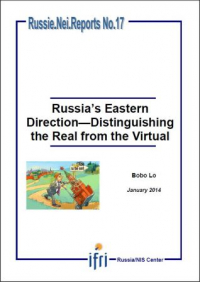Gateway to Think Tanks
| 来源类型 | Publications - Reports - Russie.NEI.Reports |
| 规范类型 | 报告 |
| DOI | 978-2-36567-226-9 |
| Russia's Eastern Direction - Distinguishing the Real from the Virtual Russie.Nei.Report, No. 17, January 2014 | |
| Bobo LO | |
| 发表日期 | 2014 |
| 出版年 | 2014 |
| 概述 | The Asia-Pacific region has assumed primary importance as a center of global politics and economic dynamism. For Moscow, this development highlights a world in which many long-standing assumptions about international politics are being overturned. It speaks of “global power … shifting to the... |
| 摘要 |
Russia's Eastern Direction - Distinguishing the Real from the Virtual Russie.Nei.Report, No. 17, January 2014
The Asia-Pacific region has assumed primary importance as a center of global politics and economic dynamism. For Moscow, this development highlights a world in which many long-standing assumptions about international politics are being overturned. It speaks of “global power … shifting to the East,” and of Russia becoming involved in the “dynamic integration processes in the ‘new Asia".” But for all the rhetoric about a “turn to the East”, Russia’s commitment to serious engagement with the Asia-Pacific is uncertain. Its elite retains a strongly Western-centric world-view, even as it criticizes Western shortcomings.  Although Moscow has begun to appreciate Asia as important in and of itself, it is mainly concerned to assert Russia as an “independent” Eurasian center of power within the “polycentric system of international relations”. Cooperation with Asian countries is the means to a larger end rather than the end itself. The outcome of these contradictions is predictably mixed. On the one hand, Moscow is investing greater effort into the Asia-Pacific—a focus heightened by the critical importance of the “strategic partnership” with China, the vulnerability of the Russian Far East, and the need to diversify energy exports. On the other hand, Russia remains a peripheral actor in the region—a country that may be in Asia, but is far from being of Asia. The Kremlin’s tendency to see international relations primarily in terms of Great Power relations means, in particular, that it does not have an Asia policy so much as a policy toward the major Asian powers, above all China. Over the next decade, Putin will continue to prioritize the relationship with Beijing, and Russia’s China-dependence will increase despite efforts to diversify ties with Japan, Vietnam, and India. Economic engagement will be dominated by energy exports, although Russia will be a niche rather than primary supplier of Asian requirements. More generally, the Asia-Pacific will remain a secondary “vector” for Moscow, and the vision of Russia as a “Euro-Pacific power” aspirational at best.
Russia's Eastern Direction—Distinguishing the Real from the Virtual
|
| URL | https://www.ifri.org/en/publications/etudes-de-lifri/russieneireports/russias-eastern-direction-distinguishing-real-virtual |
| 来源智库 | French Institute of International Relations (France) |
| 引用统计 | |
| 资源类型 | 智库出版物 |
| 条目标识符 | http://119.78.100.153/handle/2XGU8XDN/415785 |
| 推荐引用方式 GB/T 7714 | Bobo LO. Russia's Eastern Direction - Distinguishing the Real from the Virtual Russie.Nei.Report, No. 17, January 2014. 2014. |
| 条目包含的文件 | ||||||
| 文件名称/大小 | 资源类型 | 版本类型 | 开放类型 | 使用许可 | ||
| capture_rnr_17_.jpg(35KB) | 智库出版物 | 限制开放 | CC BY-NC-SA |  浏览 | ||
| ifrirnr17boboloeaste(303KB) | 智库出版物 | 限制开放 | CC BY-NC-SA | 浏览 | ||
除非特别说明,本系统中所有内容都受版权保护,并保留所有权利。